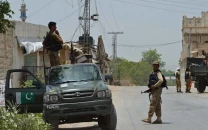Before the terror

Before the terror
The three artists featured are Aijaz Anwar from Lahore, Ghulam Shabbier from Peshawar and Ghalib Baqar from Karachi. With art pieces on various aspects of cultural, political and social issues, the artists sometimes project an idealistic visual environment within their personal style of aesthetic expression. They shared their views about how their cities have changed and become rather volatile playgrounds for violence in the last few decades.
Aijaz Anwar said, “Lahore, the cultural capital of Pakistan, is today infested with lop-sided psychopaths, who, in all their ignorance, want to destroy what our fathers had so painstakingly put together over the centuries to give it [the city] a typical oriental look.” “My humble endeavour is to highlight the glory in peril. We shall not let the forces of ignorance destroy the tranquillity of it. The light and shade falling over the projecting jharokas, the textured masonry, people in the streets below; they need all our protection, morally and practically, against the bigotry,” he said. Peshawar is one of the seven oldest cities in the world, according to Ghulam Shabbier. The lives and culture of Peshawaris has evolved over thousands of years.
Until recently, the people of Peshawar used to do business, on the one hand, with Russia, and on the other, with India. “The change of kings had a deep effect on the fortunes of this city and its people,” he said. But by the same token, Peshawar and its natives suffered tremendously as well. The two events that have had profoundly affected the city were the Bolshevik revolution of Russia and the Russian invasion of Afghanistan, he said.
The revolution turned the riches of Peshawar to rags overnight, while the Russian invasion brought millions of Afghanis to the relatively small city of Peshawar, destroying the fragile infrastructure and diluting the Peshawari culture further, he said. “I was born in Peshawar and have lived here for most of my life. I have portrayed the life of my city and its people as it once was, as I remember it from my childhood and as I wish it to be,” Shabbier said. Ghalib Baqar depicts the situation of the Afghan jihad during the 1980s. The jihad had a negative impact on art and culture in Pakistani society when rulers tried to impose their own strict codes and moral standards in a bid to introduce a puritan culture in the country.
But even after the Afghan jihad ended, the situation continued to deteriorate in Peshawar, as many jihadi offshoots emerged. They recruited young boys to continue jihad in Pakistan and the rest of the world. Sectarian violence, deteriorating law and order, attacks on theatres, and suicide bombings in public places have thrust the major urban centres of the country, including Karachi and Lahore, into an unending nightmare, Baqar said. Nomad will extend this topic, ‘Mera Shehr’, to other cities in Pakistan, said Nageen Hyat, Director of the gallery.
Published in the Express Tribune, May 18th, 2010.



















COMMENTS
Comments are moderated and generally will be posted if they are on-topic and not abusive.
For more information, please see our Comments FAQ